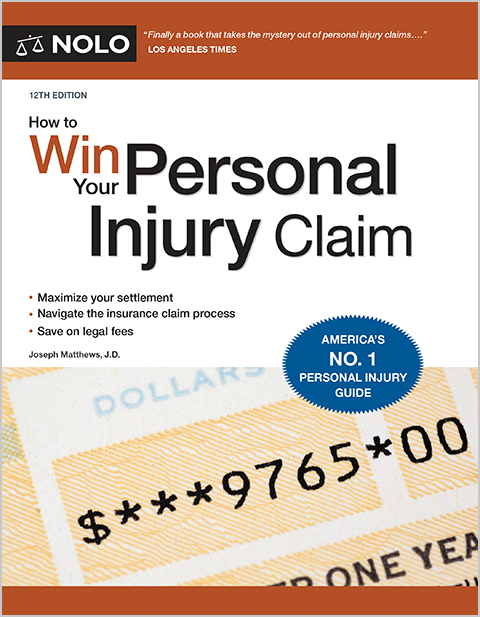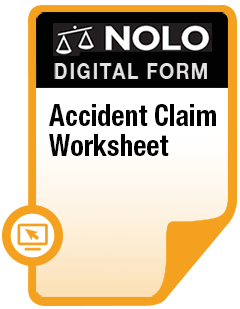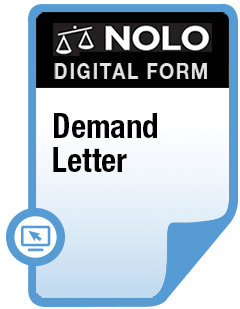We walk you through the steps to create a complete and convincing personal injury demand letter.
As the name suggests, a settlement demand letter is a letter you send to whoever you think is legally responsible (liable) for your injuries, demanding a sum of money to resolve your claims. When you're trying to settle a personal injury case, the demand letter often serves as the centerpiece of the negotiation process.
In a well-written demand letter, you spell out for the other side (or in most cases, the other side's insurance adjuster):
- the key facts
- your injuries and the medical treatment you received
- the costs of your treatment
- your lost wages and all other out-of-pocket expenses
- all of your other damages, like pain and suffering, emotional distress, and disability, and
- why the other side is to blame for your injuries and damages—and why you're not.
Your letter concludes with a demand for a lump sum to settle your claim. We'll take a closer look at these elements shortly, but first things first.
Before You Start Writing Your Demand Letter
Don't start writing your demand letter until you've done some preparation and planning. In particular, you should:
- gather evidence to support your claims
- review your notes, records, and other documents, and
- do any necessary legal research.
Gather All Your Evidence
Before you start writing your personal injury demand letter, make sure you have copies of all your medical, pharmaceutical, and other records and bills. If you missed work or had to take PTO, get a letter from your employer's human resources office documenting the time you were away and how much income or accumulated PTO you lost.
You may need to gather other evidence as well, like witness statements, pictures and videos of the accident scene, or a police report. Have all this evidence at hand so you don't have to delay sending your letter while you do additional legwork.
Review Your Notes
Before you begin to write your demand letter, review your notes from the days and weeks following the accident to remind yourself of the details—what happened, how you were hurt, your pain and discomfort, the inconvenience and disruption of your life, and your medical treatment.
Learn more about why it's important to take notes after an accident or injury.
At the same time, you'll want to review your medical records, the police report, photos and videos of the scene, and any witness statements. This review is also a good opportunity to make sure that you have all the documentation you need. If not, now's the time to fill any gaps.
Do Some Legal Research
You want the insurance adjuster to know that you have at least a basic understanding of the law. That means you'll probably need to do some online research into things like fault, negligence, and the duty of care. You should know about the different kinds of damages and how to explain them in your demand letter. Finally, take the time to learn about how a personal injury lawsuit works if settlement talks fail and you have to file in court.
Here's a helpful introduction to laws and legal research, and a compilation of online legal research sites.
Style Points
Your demand letter is almost certainly going to wind up on the desk of an insurance adjuster. This person's only job is to investigate and settle personal injury claims just like yours. Personal insults, wild, unprovable claims, and overblown emotional rhetoric won't do you any good. Quite the opposite: You'll expose yourself as an amateur, whose claim and demand don't need to be taken seriously.
Your demand letter should be complete, thorough, and factual. Remember that the adjuster might respond to anything you say by asking you to explain or prove it. Don't make assertions that you can't back up with proof. Describe your injuries, including your pain and suffering, in as much detail as needed to give a full picture of what happened to you.
Finally, keep your demand reasonable. If you have medical bills of $2,800 and you demand $1 million to settle, you'll never regain your lost credibility.
What to Cover in Your Demand Letter
Your settlement demand needs to cover the facts, how you were hurt and the treatment you received, any lasting injuries or disabilities you've suffered, why the other side is to blame (and you're not), and your damages. You conclude the letter with a monetary demand.
The Facts
Begin by describing who was involved, what happened, and when and where it happened. Be sure you tell the complete story as you experienced it, but don't waste time with things that aren't relevant. What you had for breakfast the morning you were injured, for instance, doesn't matter—unless you're bringing a claim for food poisoning against the restaurant where you ate.
You've heard the old line that there are two sides to every story. That's true in most personal injury cases. But your demand letter isn't the place to tell both sides. The insurance adjuster already has your opponent's story. This is your chance to tell your side.
Don't make up facts, don't lie, and don't exaggerate. As soon as the insurance adjuster catches you changing your story, you've lost.
Your Injuries and Medical Treatment
Describe all your injuries, both physical and emotional, and all the treatments you've received. And don't be shy. Emphasize your pain, the length and difficulty of your recovery, and any negative effects your injuries have had on your daily life (such as "pain and suffering," and your "emotional distress"). Be sure to talk about any long-term or permanent injuries, especially if they're disabling or disfiguring.
Try to use appropriate medical terminology to describe your injuries. Saying you suffered a "complete transverse fracture of the distal fibula requiring internal fixation" conveys more information than just saying "I had a broken ankle bone and the doctor had to operate." A site like Web MD will explain medical conditions and treatments, and there's a medical dictionary to define terms.
You'll need medical evidence to back up your claims of injury and disability. Make sure that everything is documented in your medical records or in a letter from your doctor. If you're making a claim for future medical care, you'll need proof for that as well.
Don't make things up or be overly dramatic. Insurance adjusters have heard it all, and they'll turn a deaf ear to claims they believe are false or can't be proved.
Liability, or Why the Other Side Is Responsible and You're Not
Your demand letter must explain why the other party is legally responsible for your injuries and damages. That probably means showing the other side was negligent. You might also need to explain why you weren't to blame for the accident.
Negligence
In nearly all personal injury cases, proving that the other side was responsible means explaining how they were negligent. Negligence happens when someone's conduct falls short of the applicable duty of care. In addition, you've got to demonstrate that the other party's negligence caused your injuries and damages.
This sounds like a lot of complicated stuff, but in many cases, it can be broken down into simple terms. In a car wreck case, for example, where the other side ran a stop sign and hit you, it might go something like this:
You should also mention any outside support you have for your theory—a police report in a car accident case, relevant building code sections that may have been violated in a slip and fall claim, or witness statements.
Comparative Negligence
In many cases, the other side will argue that your own negligence contributed to the accident. Depending on the state where you live, this might be called comparative negligence or contributory negligence. At the demand letter stage, you should meet this issue head-on by denying that you share any fault for what happened.
Even if you believe you might have been partly at fault, don't admit that in your demand letter. Although you need to consider your own carelessness in deciding what a fair settlement might be, it's not your job to make these arguments for the insurance company. If the insurance adjuster brings up the subject during settlement negotiations, you can debate the question then.
But take note: If the adjuster insists that your fault is an issue, you need to consider hiring an experienced personal injury attorney. In some states, your comparative or contributory negligence might kill your claim entirely. That's not an issue you want to tackle on your own.
Your Damages
In legal terms, your injuries are the physical and emotional harms you suffered. Damages are how the law puts a dollar value on those injuries. Personal injury damages come in two basic categories. The first is "economic" damages, sometimes called "special" damages. The second is "noneconomic" damages, sometimes called "general" damages.
List Your Economic Damages
Economic damages are the losses that come directly out of your (or your health insurer's) pocket—medical bills, lost wages, and pharmacy charges are the most common examples. List and total all of your economic damages. As we'll see, you need a total for your medical expenses before you can calculate your noneconomic damages.
Calculate Your Noneconomic Damages
Noneconomic damages are losses that don't come directly out of your pocket—things like pain and suffering, emotional distress, and disability and disfigurement. How do you put a dollar value on these damages? There's no one "correct" rule, but most insurance companies and personal injury lawyers use a multiple of medical expenses to compute noneconomic damages.
So, for example, let's say your medical expenses total $6,500. A typical noneconomic damages multiplier is two or three, but might be five or higher if the facts are particularly shocking or your injuries are severe and permanent. For ease of illustration, we'll use a multiplier of three. This would mean your noneconomic damages are $19,500 ($6,500 x 3).
Start with a multiplier that results in noneconomic damages higher than what you're really willing to accept. This leaves you with room to negotiate downward. If you start with your bottom-dollar settlement figure, you've got nowhere to go.
Your Settlement Demand
At this point, all the hard work is done. Add together your total economic and noneconomic damages to arrive at your total damages. Demand this figure to settle all your claims. The insurance adjuster will come back with a number that's well below yours. Let the negotiations begin.
Other Things to Consider
You might want to let the insurance adjuster know that your letter is a prefiling settlement demand, and that if you must file suit you'll ask a jury to award you a much higher sum. The adjuster knows this, but a gentle reminder never hurts.
Finally, make it clear that because your demand letter is an attempt to settle your claims, nothing in the letter will be admissible in evidence if the case goes to trial.
More Help With Your Personal Injury Demand Letter
For help tailoring your demand letter to the specifics of your accident and making your best argument, see How to Win Your Personal Injury Claim, by Joseph L. Matthews (Nolo). And check out Nolo's claim-specific collection of sample demand letters before putting together your own demand to the insurance company.


